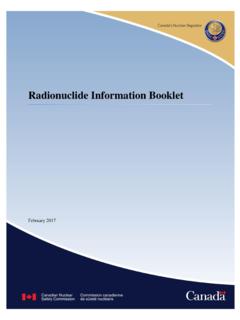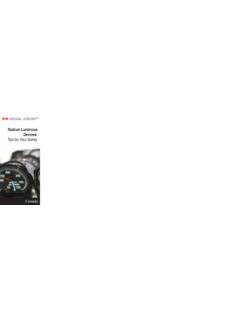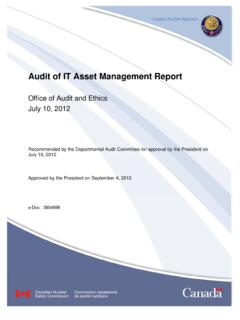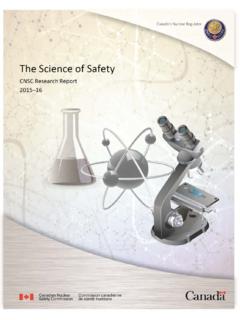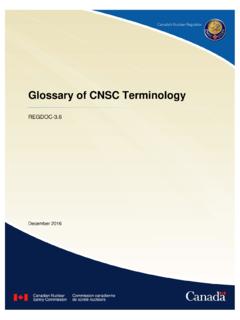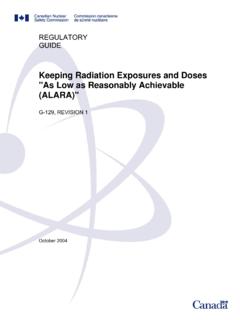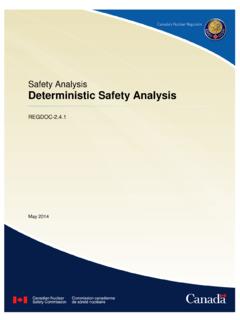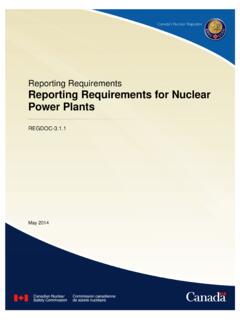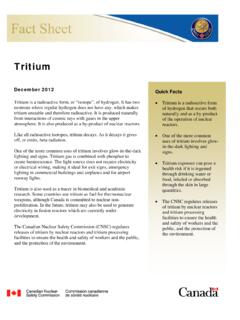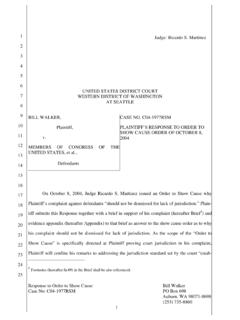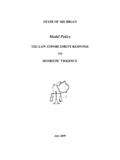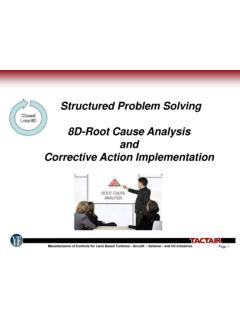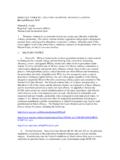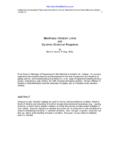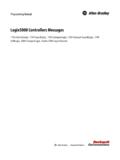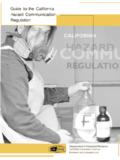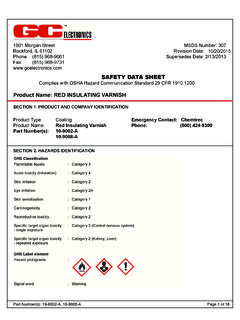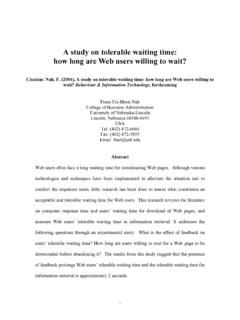Transcription of Alarm Response Guidelines for Radiation Portal …
1 Alarm Response Guidelinesfor Radiation Portal Monitoring SystemsAlarm Response Guidelines for Radiation Portal Monitoring Systems Minister of Public Works and Government Services Canada 2011 Catalogue number CC172-68/1-2011E-PDFISBN 978-1-100-17916-2 Published by the Canadian Nuclear Safety Commission, February 2011 CNSC Catalogue number: INFO-0814 Extracts from this document may be reproduced for individual use without permission provided the source is fully acknowledged. However, reproduction in whole or in part for purposes of resale or redistribution requires prior written permission from the Canadian Nuclear Safety Commission. galement publi en fran ais sous le titre de: Directives d intervention en cas d alarme de portiques de d tection des rayonnementsDocument availabilityThis document can be viewed on the CNSC Web site at To order a printed copy of the document in English or French, please contact:Canadian Nuclear Safety Commission280 Slater Box 1046, Station BOttawa, Ontario K1P 5S9 CANADATel.
2 : 613-995-5894 or 1-800-668-5284 (in Canada only)Facsimile: 613-995-5086 Email: site: courtesy of: BFI Canada, Overwatch Response Guidelines1 Alarm Response GuidelinesAlarm Response Guidelines for Radiation Portal Monitoring SystemsIntroduction The Canadian Nuclear Safety Commission (CNSC) created this brochure as well as a poster to offer Alarm Response Guidelines for Radiation Portal monitoring systems. These will provide: guidance and Response actions to be taken in the event that a Radiation Portal monitor Alarm is activated safety aspects to consider when dealing with unidentified radioactive nuclear substances hazards and risks associated with nuclear substances and Radiation devices information related to the detection of nuclear substances and Radiation devicesNuclear substances and Radiation devices are widely used throughout Canada in many application fields, which include industrial, medical, education and research.
3 Radioactive sources are used in both sealed and unsealed forms. The sealed form generally consists of a nuclear substance encased within a metal capsule, and is usually incorporated into a Radiation device designed for industrial use. Unsealed radioactive sources can be in liquid or solid form, and are commonly used in medical diagnostic and therapeutic treatments, as well as in laboratory research applications. The CNSC is the federal authority responsible for the regulation of nuclear substances and Radiation devices in Canada. A licence issued by the CNSC is required for the possession and use of nuclear substances and Radiation devices. There are, however, small quantities of nuclear substances that are exempt from licensing, because they represent a low risk to the public and the environment.
4 Examples of items that are exempt from CNSC licensing include residential smoke detectors, building exit signs, naturally occurring nuclear substances and outpatient waste from individuals who have received a nuclear medicine Response Guidelines2 Occasionally, radioactive nuclear substances have been found in the public domain, in areas such as waste management and scrap metal recycling facilities. This represents a matter of concern, since undetected radioactive nuclear substances in appreciable amounts may cause unnecessary risk to members of the public, facility workers and the environment. If nuclear substances enter the metal recycling processing stream, equipment and products can be contaminated, resulting in significant financial impacts due to clean-up the years, numerous waste management and scrap metal recycling facilities have purchased and installed Radiation Portal monitor systems at their locations.
5 These monitoring systems are used to detect the presence of radioactive nuclear substances in incoming shipments of materials to their facilities. The use of Radiation Portal monitors to detect the presence of radioactive nuclear substances has therefore reduced the potential of these materials entering waste management and metal recycling processing most cases, the alarms are activated by items containing very low levels of radioactive materials that do not require a CNSC licence, being exempt from regulation. Items and materials containing nuclear substances detected at waste management facilities and scrap metal recycling facilities include: smoke detectors devices that contain a radium luminous compound low activity check sources naturally occurring nuclear substances outpatient waste from individuals who have received a nuclear medical treatment with a nuclear substanceHowever, in some cases, the alarms may be activated by radioactive material that has not been disposed of appropriately, or has been illegally discarded with normal waste or scrap.
6 On occasion, an orphan source is discovered in normal waste or Response Guidelines3 Smoke detectors are among the most important fire safety devices found in many homes. One of the most common types of smoke detector contains an ionization chamber and a small quantity of americium-241(Am-241), which is radioactive. These devices do not require a licence, although their manufacture and initial distribution are licensed by the CNSC. Older smoke detectors containing radium-226 (Ra-226) have been detected occasionally, although this type of smoke detector is no longer manufactured or distributed in of smoke detectorsOlder smoke detector containing radium-226 Household smoke detector Alarm Response Guidelines4A device that contains a radium luminous compound is not radioactive in itself.
7 The radioactivity is associated with the radium-based paint in the device, which causes it to glow in the dark. The luminous compound consists of radium salts mixed with a chemical phosphor. The resulting compound is luminescent, which made it popular during the first half of the 20th century for use in watch and clock faces, maritime compasses, and a variety of military items and aircraft instruments. The production of radium luminous products ended in the 1960s, and the use of radium in consumer products pre-dates the establishment of regulatory control of nuclear substances in Canada. Nonetheless, there are still many items with radium luminous paint. They sometimes show up in places such as antique stores, museums, junkyards, or garage sales, eventually ending up in waste or scrap metal recycling of devices that contain a radium luminous compound For more information on devices that contain a radium luminous compound, please visit the CNSC Web site at: Response Guidelines5 Low activity check sources are composed of a nuclear substance that is deposited on a plastic disc and then sealed with epoxy to prevent leakage and contamination.
8 These items are typically used to verify the Response of a variety of Radiation detection of low activity check sourcesNaturally occurring nuclear substances are radioactive substances that are naturally found in the environment. These include uranium, thorium and a radioactive form of potassium, and any of their radioactive decay products, such as radium and radon. These elements have always been present in the Earth s crust and within the tissues of all living beings. Naturally occurring nuclear substances that are not associated with the nuclear fuel cycle do not come under the control of the CNSC, except for Import/Export and Transport. Their presence is detected in everyday items this includes thorium-232 (Th-232) in items such as brake linings, jet engines, refractory bricks, and ceramic air blasting beads.
9 Depleted uranium is used in armour-piercing projectiles, while uranium-238 is found in various other items such as construction bricks and gypsum Response Guidelines6 Examples of naturally occurring nuclear substances found in manufactured productsThorium-232 in ceramic air blasting beadsGranite roller Ceramic resistorsAlarm Response Guidelines7 Thorium-232 in brake liningsJet engine, firebrick and shred log containing naturally occurring nuclear substances Alarm Response Guidelines8 Nuclear medicine is the term used when nuclear substances are incorporated into pharmaceuticals for the diagnosis, management and treatment of diseases. They are designed to target specific tissues and organs, allowing the delivery of their Radiation to a specific area of the body.
10 The most common nuclear substances used in nuclear medicine are chromium-51 (Cr-51), indium-111 (In-111), iodine-131 (I-131), gallium-67 (Ga-67), technetium-99 m (Tc-99 m), and thallium-201 (Tl-201). Radioactive articles of nuclear medicine patients most commonly appear in household trash bound for solid waste landfill of articles used in nuclear medical treatments that may be contaminated with nuclear substances:Iodine-131 contaminated saliva on stamps; outpatient personal items contaminated with medical nuclear substances Alarm Response Guidelines9An orphan source is a radioactive source that is not under proper regulatory control. It may have been abandoned, lost, misplaced, stolen or otherwise transferred without proper authorization.
